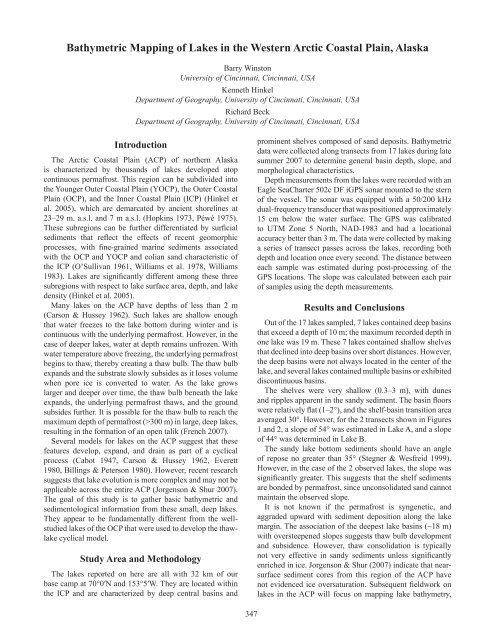Ninth International Conference on Permafrost ... - IARC Research
Ninth International Conference on Permafrost ... - IARC Research
Ninth International Conference on Permafrost ... - IARC Research
You also want an ePaper? Increase the reach of your titles
YUMPU automatically turns print PDFs into web optimized ePapers that Google loves.
Bathymetric Mapping of Lakes in the Western Arctic Coastal Plain, AlaskaBarry Winst<strong>on</strong>University of Cincinnati, Cincinnati, USAKenneth HinkelDepartment of Geography, University of Cincinnati, Cincinnati, USARichard BeckDepartment of Geography, University of Cincinnati, Cincinnati, USAIntroducti<strong>on</strong>The Arctic Coastal Plain (ACP) of northern Alaskais characterized by thousands of lakes developed atopc<strong>on</strong>tinuous permafrost. This regi<strong>on</strong> can be subdivided intothe Younger Outer Coastal Plain (YOCP), the Outer CoastalPlain (OCP), and the Inner Coastal Plain (ICP) (Hinkel etal. 2005), which are demarcated by ancient shorelines at23–29 m. a.s.l. and 7 m a.s.l. (Hopkins 1973, Péwé 1975).These subregi<strong>on</strong>s can be further differentiated by surficialsediments that reflect the effects of recent geomorphicprocesses, with fine-grained marine sediments associatedwith the OCP and YOCP and eolian sand characteristic ofthe ICP (O’Sullivan 1961, Williams et al. 1978, Williams1983). Lakes are significantly different am<strong>on</strong>g these threesubregi<strong>on</strong>s with respect to lake surface area, depth, and lakedensity (Hinkel et al. 2005).Many lakes <strong>on</strong> the ACP have depths of less than 2 m(Cars<strong>on</strong> & Hussey 1962). Such lakes are shallow enoughthat water freezes to the lake bottom during winter and isc<strong>on</strong>tinuous with the underlying permafrost. However, in thecase of deeper lakes, water at depth remains unfrozen. Withwater temperature above freezing, the underlying permafrostbegins to thaw, thereby creating a thaw bulb. The thaw bulbexpands and the substrate slowly subsides as it loses volumewhen pore ice is c<strong>on</strong>verted to water. As the lake growslarger and deeper over time, the thaw bulb beneath the lakeexpands, the underlying permafrost thaws, and the groundsubsides further. It is possible for the thaw bulb to reach themaximum depth of permafrost (>300 m) in large, deep lakes,resulting in the formati<strong>on</strong> of an open talik (French 2007).Several models for lakes <strong>on</strong> the ACP suggest that thesefeatures develop, expand, and drain as part of a cyclicalprocess (Cabot 1947, Cars<strong>on</strong> & Hussey 1962, Everett1980, Billings & Peters<strong>on</strong> 1980). However, recent researchsuggests that lake evoluti<strong>on</strong> is more complex and may not beapplicable across the entire ACP (Jorgens<strong>on</strong> & Shur 2007).The goal of this study is to gather basic bathymetric andsedimentological informati<strong>on</strong> from these small, deep lakes.They appear to be fundamentally different from the wellstudiedlakes of the OCP that were used to develop the thawlakecyclical model.Study Area and MethodologyThe lakes reported <strong>on</strong> here are all with 32 km of ourbase camp at 70°0′N and 153°5′W. They are located withinthe ICP and are characterized by deep central basins andprominent shelves composed of sand deposits. Bathymetricdata were collected al<strong>on</strong>g transects from 17 lakes during latesummer 2007 to determine general basin depth, slope, andmorphological characteristics.Depth measurements from the lakes were recorded with anEagle SeaCharter 502c DF iGPS s<strong>on</strong>ar mounted to the sternof the vessel. The s<strong>on</strong>ar was equipped with a 50/200 kHzdual-frequency transducer that was positi<strong>on</strong>ed approximately15 cm below the water surface. The GPS was calibratedto UTM Z<strong>on</strong>e 5 North, NAD-1983 and had a locati<strong>on</strong>alaccuracy better than 3 m. The data were collected by makinga series of transect passes across the lakes, recording bothdepth and locati<strong>on</strong> <strong>on</strong>ce every sec<strong>on</strong>d. The distance betweeneach sample was estimated during post-processing of theGPS locati<strong>on</strong>s. The slope was calculated between each pairof samples using the depth measurements.Results and C<strong>on</strong>clusi<strong>on</strong>sOut of the 17 lakes sampled, 7 lakes c<strong>on</strong>tained deep basinsthat exceed a depth of 10 m; the maximum recorded depth in<strong>on</strong>e lake was 19 m. These 7 lakes c<strong>on</strong>tained shallow shelvesthat declined into deep basins over short distances. However,the deep basins were not always located in the center of thelake, and several lakes c<strong>on</strong>tained multiple basins or exhibiteddisc<strong>on</strong>tinuous basins.The shelves were very shallow (0.3–3 m), with dunesand ripples apparent in the sandy sediment. The basin floorswere relatively flat (1–2°), and the shelf-basin transiti<strong>on</strong> areaaveraged 30°. However, for the 2 transects shown in Figures1 and 2, a slope of 54° was estimated in Lake A, and a slopeof 44° was determined in Lake B.The sandy lake bottom sediments should have an angleof repose no greater than 35° (Stegner & Wesfreid 1999).However, in the case of the 2 observed lakes, the slope wassignificantly greater. This suggests that the shelf sedimentsare b<strong>on</strong>ded by permafrost, since unc<strong>on</strong>solidated sand cannotmaintain the observed slope.It is not known if the permafrost is syngenetic, andaggraded upward with sediment depositi<strong>on</strong> al<strong>on</strong>g the lakemargin. The associati<strong>on</strong> of the deepest lake basins (~18 m)with oversteepened slopes suggests thaw bulb developmentand subsidence. However, thaw c<strong>on</strong>solidati<strong>on</strong> is typicallynot very effective in sandy sediments unless significantlyenriched in ice. Jorgens<strong>on</strong> & Shur (2007) indicate that nearsurfacesediment cores from this regi<strong>on</strong> of the ACP havenot evidenced ice oversaturati<strong>on</strong>. Subsequent fieldwork <strong>on</strong>lakes in the ACP will focus <strong>on</strong> mapping lake bathymetry,347
















